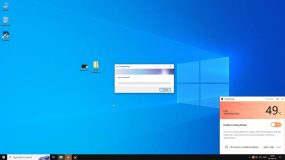A Blue Screen of Death, more popularly referred to as a BSOD, is an error that sends Windows into a critical crash. In most cases, upon the occurrence of a BSOD, the system displays some type of error code on a bright blue screen to show what actually caused the crash. BSODs generally occur when an operating system encounters an error that cannot be recovered.
BSOD errors such as DRIVER_IRQL_NOT_LESS_OR_EQUAL usually show some problem with either drivers or memory and usually need some troubleshooting to exactly locate the cause. Causes may include a faulty device driver, flawed hardware, or corrupted operating system files.
About DRIVER_IRQL_NOT_LESS_OR_EQUAL Error
The DRIVER_IRQL_NOT_LESS_OR_EQUAL is a Blue Screen of Death (BSOD) bug check that can appear randomly. It typically appears with the message “Stop code error ipeaklwf.sys failed.“
The error typically occurs when a system driver is installed, corrupted, or incompatible. At times, defective hardware can also trigger the error. When the crash occurs, Windows automatically creates a crash dump file in the location provided. This file captures details on the issue, such as which driver or hardware was responsible for the crash.

How to Fix DRIVER_IRQL_NOT_LESS_OR_EQUAL Error
Repair the Registry Keys Associated with DRIVER_IRQL_NOT_LESS_OR_EQUAL Error
BSOD errors can also be the result of some actual damage or corruption of certain registry keys. Scan and repair them efficiently with the proper kind of tool Outbyte PC Repair. This will help restore stability and remove part of the inconsistencies in the registry.
Perform a Full Malware Scan
It is possible that malware might infect system files and, thus, cause such errors to appear-including the DRIVER_IRQL_NOT_LESS_OR_EQUAL error. Perform a full scan with a reputable antivirus application capable of finding malware and deleting the detected items. If in doubt over which antivirus application to use, then perhaps try Outbyte AVarmor, which is quite solid in terms of malware protection.
Clear Out System Junk
Over time, these temporary files and system junk can build up and cause problems with your system’s performance or even errors. Use Disk Cleanup or a third-party utility to delete these superfluous files. Keeping your system clutter-free means much smoother operation.
Update Your Device Drivers
Usually, the problem is connected with incompatible or outdated drivers. Open Device Manager, locate the problematic driver, and update it manually. Alternatively, install a good utility Outbyte Driver Updater. It automatically detects all outdated drivers on your PC and updates them.
In our Driver library you can find the most suitable Chipsets Drivers for your OS and a short guide on how to install it.
Read also about our popular Drivers:
Install Any Available Windows Updates
Microsoft often releases updates for system vulnerabilities and compatibility too.
Go to Settings > Update & Security > Windows Update and check for updates. Pending updates usually resolve BSOD error codes.
Use System Restore
Well, there is a utility in Windows called System Restore to which you can simply toggle your system settings back to some previous time when everything was running smoothly. Alternatively, cut in half the number of hours you have to spend troubleshooting this DRIVER_IRQL_NOT_LESS_OR_EQUAL error.
To open System Restore:
- Type in the Search box System Restore and press Enter.
- Under results, click System Restore.
- You may be prompted for your administrator credentials.
- Use the System Restore Wizard to follow the instructions for selecting a restore point.
- When done, reboot your computer.
Run System File Checker
The System File Checker tool, included on most Windows devices, scans for corrupted system files and repairs them, including those that may be causing DRIVER_IRQL_NOT_LESS_OR_EQUAL errors.
To run the System File Checker:
- In the Search box, type
command. - While holding down Ctrl + Shift, press Enter. This will open the Command Prompt with administrator privileges.
- In the permission dialog box, click Yes.
- In Command Prompt, type
sfc /scannowand then press Enter. - Wait; this will scan your system, taking a little time. Follow any on-screen instructions. Restart your computer once the finish happens.
People Also Ask
DPC Watchdog Violation BSOD error
“Automatic Repair Is Not Working” Error
How to Fix the 0x800F0831 Error Code on Windows 10/11?
DRIVER_POWER_STATE_FAILURE Error
“Display Driver Nvlddmkm Stopped Responding and Has Successfully Recovered” Error
FAQs
What are the basic causes of the DRIVER_IRQL_NOT_LESS_OR_EQUAL error?
The root causes for this type of error mainly involve corrupted or outdated drivers, flawed hardware, malware, and registry problems.
How would I know which driver is at fault?
Either open Event Viewer to find this, or look at the BSOD error message at the point in which it names the name of the problematic driver.
Is the error caused by outdated Windows Updates?
Yes, missing or older updates of drivers can introduce incompatibility that results in BSOD errors.
Can BSODs be prevented in the future?
Well, yes, regular updates of your drivers and system, periodic scanning for malware, and cleaning system junk may reduce the frequency of the BSODs.





